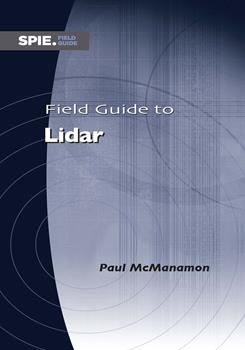BibliographyAlexander S. B., Optical Communication Receiveer Design, SPIE Press, Bellingham, Washington
(1997). Google Scholar
Beck S., Buck J., Buell W., Dickinson R., Kozlowski D., Marechal N., Wright T., ““Synthetic aperture imaging laser radar: Laboratory demonstration and signal processing,”,” Appl. Opt, 44 (35), 7621–7629 (2005). Google Scholar
Fox C. S., Accetta J. S., Shoemaker D. L., Active Electro-Optical SystemsThe Infrared & Electro-Optical Systems Handbook,, Environmental Research Institute of Michigan, Ann Arbor, Michigan and SPIE Optical Engineering Press, Bellingham, Washington
(1993). Google Scholar
Compana S. B., Accetta J. S., Shoemaker D. L., Passive Electro-Optical Systems, The Infrared and Electro-Optical Systems Handbook, Environmental Research Institute of Michigan, Ann Arbor, Michigan and SPIE Optical Engineering Press, Bellingham, Washington
(1993). Google Scholar
Fujii T., Fukuchi T., Laser Remote Sensing, Taylor and Francis Group, Boca Raton, Florida
(2005). Google Scholar
Henderson S. W., Gatt P., Rees D., Huffaker M., Fujii T., Fukuchi T., ““Wind LIDAR,” Chapter 7,” Laser Remote Sensing, Taylor and Francis Group, Boca Raton, Florida
(2005). Google Scholar
Jelalian A. V., Laser Radar Systems, Artech House, Norwood, Massachusetts
(1991). Google Scholar
Keyes R. J., ““Heterodyne and nonheterodyne laser transceivers,”,” Rev. Sci. Instrum, 57 519 (1986). Google Scholar
Krause B., Buck J., Ryan C., Hwang D., Kondratko P., Malm A., Gleason A., Ashby S., ““Synthetic aperture lidar flight demonstration,”,” CLEO 2011, Laser Applications to Photonic Applications, PDPB7, Optical Society of America, Washington, D.C.
(2011). Google Scholar
Marron J. C., Kendrick R. L., Seldomridge N., Grow T. D., Hoft T. A., ““Atmospheric turbulence correction using digital holographic detection: Experimental results,”,” Opt. Exp., 17 11638 (2009). Google Scholar
McManamon P. F., ““Review of lidar: A historic, yet emerging, sensor technology with rich phenomenology,”,” Opt. Eng., 51 (6), 060901 (2012). Google Scholar
McManamon P. F., Kamerman G., Huffaker M., ““A history of laser radar in the United States,”,” Proc. SPIE, 7684 (2010). Google Scholar
Laser Radar: Progress and Opportunities in Active Electro-Optical Sensing, The National Academies Press, Washington, D.C.
(2014). Google Scholar
Osche G. R., Optical Detection Theory for Laser Applications, Wiley-Interscience, New York
(2002). Google Scholar
Overbeck J. A., Salisbury M. S., Mark M. B., Watson E. A., ““Required energy for a laser radar system incorporating a fiber amplifier or an avalanche photodiode,”,” Appl. Opt, 34 7724–7730 (1995). Google Scholar
Reibel R. R., Roos P. A., Berg T. J., Kaylor B., Greenfiend N., Barber Z. W., Renner C. J., Babbit W. R., ““Ultra-broadband optical chirp linearization for precision length metrology applications,”,” (2010). Google Scholar
Richmond R. D., Cain S. C., Direct-Detection LIDAR Systems, SPIE Press, Bellingham, Washington
(2010). Google Scholar
Siegman A. E., ““The antenna properties of optical heterodyne receivers,”,” Proc. IEEE, 54 (10), 1350–1356 (1966). Google Scholar
Dr. McManamon started at Wright-Patterson Air Force Base in May 1968 and retired from the same in 2008 as Chief Scientist of the Sensors Directorate, U.S. Air Force Research Laboratory (AFRL). Previous to that he was Senior Scientist of EO Sensors, and before that, acting chief scientist for Avionics, also at AFRL. In 2006 he received the Meritorious Presidential Rank Award. He has participated in three Air Force Scientific Advisory Board studies. He was instrumental in the development of laser flash imaging to enhance EO target recognition range by a factor of 4 or 5. Dr. McManamon was the 2006 President of SPIE. He served on the SPIE Board of Directors for seven years and on the SPIE Executive Committee for four years. In 1998, Dr. McManamon and his co-authors received the IEEE W.R.G. Baker award for best paper in any refereed IEEE journal or publication. Dr. McManamon is a Fellow of SPIE, IEEE, OSA, AFRL, MSS, AIAA, and DEPS. |
-
Journals
- Advanced Photonics
- Advanced Photonics Nexus
- Biophotonics Discovery
- Journal of Applied Remote Sensing
- Journal of Astronomical Telescopes, Instruments, and Systems
- Journal of Biomedical Optics
- Journal of Electronic Imaging
- Journal of Medical Imaging
- Journal of Micro/Nanopatterning, Materials, and Metrology
- Journal of Nanophotonics
- Journal of Optical Microsystems
- Journal of Photonics for Energy
- Neurophotonics
- Optical Engineering
- Photonics Insights
- Ebooks



